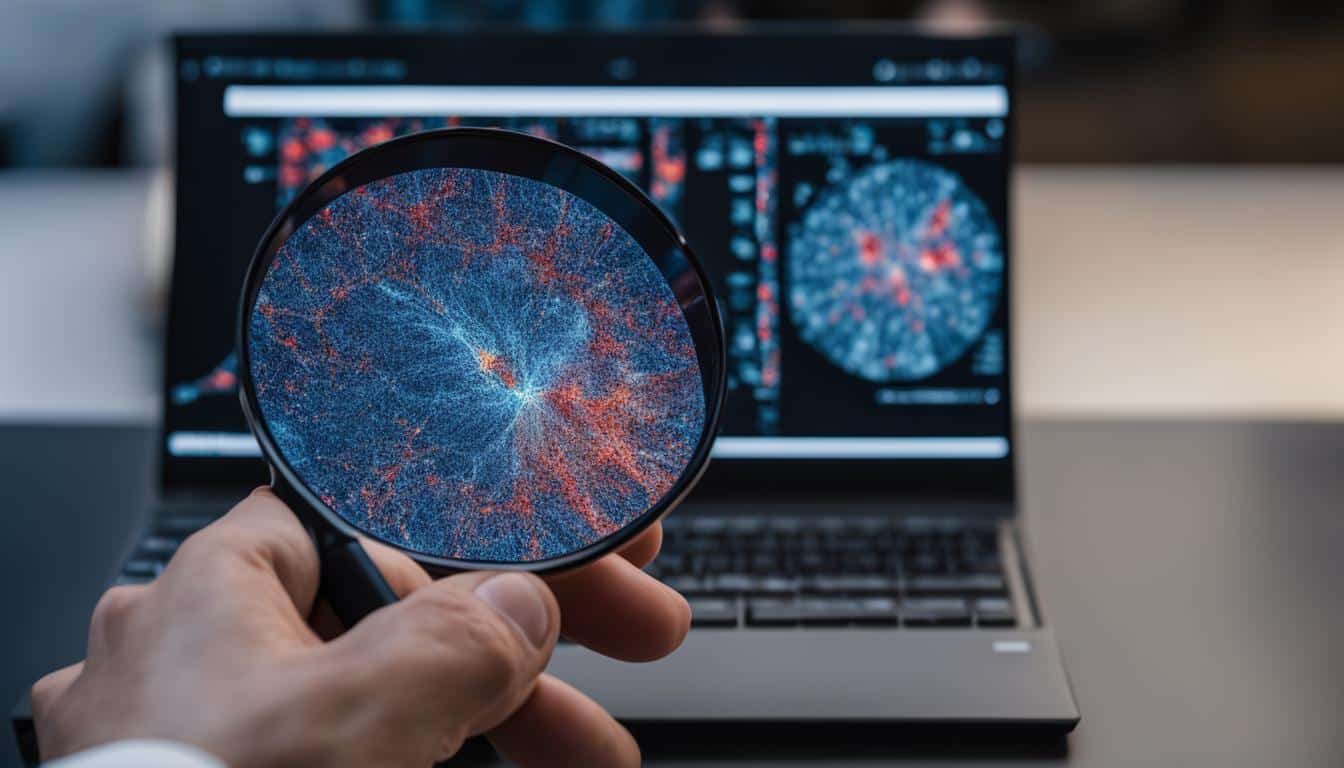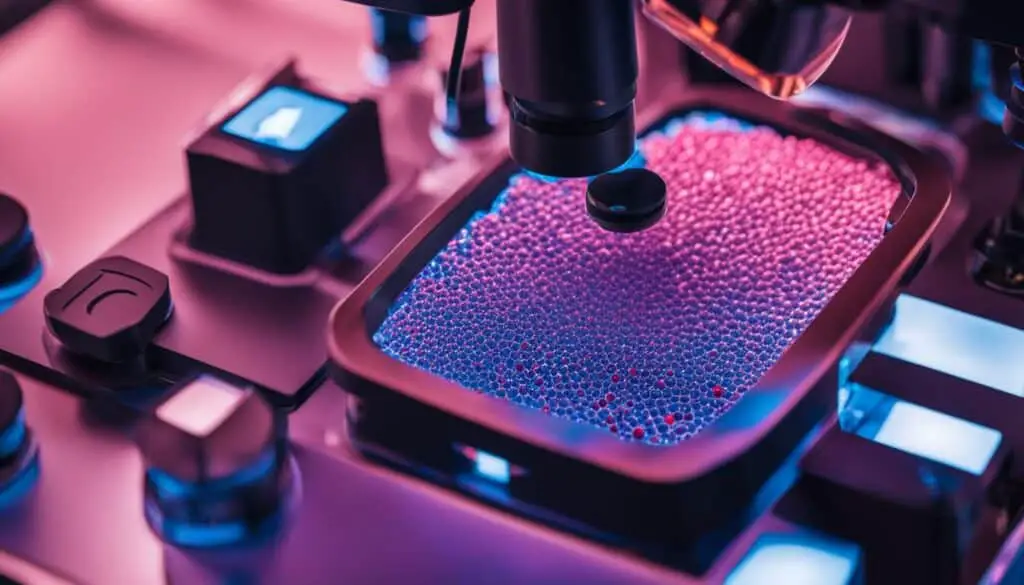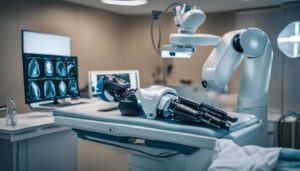
Artificial intelligence (AI) is revolutionizing the field of dermatology by enhancing analysis and care for skin health. With the help of AI, dermatologists are able to improve diagnostics, treatments, and ultimately patient outcomes. This article will explore the advancements in AI technology in dermatology and how it is transforming the way skin conditions are diagnosed and managed.
Key Takeaways
- AI is revolutionizing dermatology by improving diagnostics and treatments for skin conditions.
- Machine learning algorithms analyze skin images to accurately diagnose various skin diseases.
- AI-assisted treatment planning provides personalized care recommendations based on patient data.
- AI-enabled image analysis enhances the accuracy and speed of dermatological image interpretation.
- AI-powered tele-dermatology improves access to care, particularly for underserved areas.
AI in Skin Disease Diagnosis
In the field of dermatology, artificial intelligence (AI) is making significant advancements in the diagnosis of various skin diseases. By leveraging machine learning algorithms and analyzing extensive datasets of skin images, AI-powered systems can accurately detect patterns and abnormalities, enabling dermatologists to improve the accuracy and efficiency of skin disease diagnosis.
With the aid of AI, dermatologists can now diagnose conditions such as skin cancer, psoriasis, acne, and more with heightened precision. The machine learning algorithms employed in AI-powered systems analyze and interpret the visual characteristics of skin images, identifying subtle indications that may be difficult for human eyes to detect.
This AI-enabled diagnostic capability has the potential to revolutionize dermatology by reducing diagnostic errors and providing faster and more accurate assessments. By harnessing the power of AI in skin disease diagnosis, dermatologists can enhance patient care, streamline treatment plans, and improve overall patient outcomes.
Enhancing Diagnostic Accuracy
Machine learning algorithms utilized in AI systems have the ability to analyze vast amounts of skin images, enabling them to recognize and differentiate between various skin diseases. These algorithms learn from previous cases and continually improve their accuracy by integrating new data and insights. Through this iterative learning process, AI systems become increasingly proficient at identifying specific patterns and markers associated with different skin conditions.
By providing dermatologists with AI-driven diagnostic support, skin disease diagnosis can be enhanced by avoiding misdiagnoses or missed diagnoses. Dermatologists can rely on AI algorithms to assist in identifying early-stage skin diseases, facilitating prompt intervention and treatment.
Streamlining Diagnosis and Treatment Planning
AI in dermatology not only improves diagnosis but also streamlines treatment planning. By accurately identifying skin diseases through AI-powered systems, dermatologists can develop personalized treatment plans tailored to each patient’s specific condition.
AI algorithms can analyze diverse patient data, such as medical history, genetics, lifestyle factors, and treatment outcomes, to identify the most effective course of action. This personalized approach ensures that patients receive targeted treatments, optimizing their chances of successful outcomes.
Improving Dermatologists’ Efficiency
With the aid of AI technology, dermatologists can enhance their efficiency by automating certain aspects of skin disease diagnosis. AI systems can quickly analyze vast amounts of data and images, presenting dermatologists with potential diagnoses and recommending appropriate treatment options.
This automation enables dermatologists to spend less time on routine diagnostic tasks and focus more on providing personalized care to their patients. By leveraging AI technology, dermatologists can allocate their time and expertise more effectively, resulting in improved patient care and outcomes.
| Benefits of AI in Skin Disease Diagnosis |
|---|
| Accurate identification of various skin conditions |
| Reduced diagnostic errors and misdiagnoses |
| Enhanced efficiency in diagnosis and treatment planning |
| Improved personalized care for patients |
AI-Assisted Treatment Planning
AI is revolutionizing the field of dermatology by assisting dermatologists with personalized treatment planning. By leveraging the power of AI algorithms, dermatologists can analyze patient data to provide tailored care recommendations based on individual needs and characteristics. This AI-assisted treatment planning approach enhances the precision and efficiency of dermatological care.
One of the key benefits of AI-assisted treatment planning is the ability to deliver personalized care to patients. By analyzing patient data, including medical history, genetic factors, and treatment response, AI algorithms can generate recommendations that are specific to each patient. This personalized approach ensures that patients receive the most suitable and effective treatments for their unique conditions.
Predictive analytics is another valuable tool in AI-assisted treatment planning. By analyzing large datasets and historical treatment outcomes, AI algorithms can predict the effectiveness of different interventions. This predictive capability allows dermatologists to make informed decisions about treatment options, optimizing the chances of positive patient outcomes.
AI-assisted treatment planning also contributes to improved efficiency in dermatological care. By automating data analysis and generating personalized treatment recommendations, AI algorithms save time for dermatologists, allowing them to focus more on patient care. This not only streamlines the treatment planning process but also enables dermatologists to see more patients and reduce waiting times.
The Benefits of AI-Assisted Treatment Planning:
- Personalized care recommendations based on individual needs and characteristics
- Predictive analytics that assess the effectiveness of different interventions
- Improved efficiency in dermatological care
By harnessing the power of AI-assisted treatment planning, dermatologists can elevate the quality of care they provide to their patients. With personalized recommendations and predictive analytics, dermatologists can optimize treatment plans for better outcomes and improved patient satisfaction.
“AI-assisted treatment planning enhances the precision and efficiency of dermatological care.”

As AI continues to evolve in the field of dermatology, the potential for personalized care and enhanced patient outcomes becomes increasingly evident. The utilization of AI-assisted treatment planning in dermatological care is revolutionizing the way dermatologists approach patient treatment and is creating new possibilities for optimized care.
AI-Enabled Image Analysis
AI-enabled image analysis is revolutionizing dermatology by leveraging the power of computer vision to enhance skin imaging techniques. With the help of AI algorithms, dermatologists can analyze skin images captured through various imaging modalities, such as dermoscopy and reflectance confocal microscopy. By harnessing the capabilities of computer vision and AI, specific features and patterns in these images can be identified, aiding in the detection and characterization of various skin conditions.
AI-enabled image analysis brings remarkable improvements to the accuracy and speed of dermatological image interpretation. By automating the analysis process, dermatologists can save valuable time, allowing for quicker diagnoses and more efficient treatment planning. The ability of AI algorithms to detect subtle details and patterns that may be missed by human observation enhances the diagnostic capabilities of dermatologists and contributes to more accurate and confident diagnosis.
Advantages of AI-Enabled Image Analysis:
- Improved diagnostic accuracy: AI algorithms can identify specific features and patterns in skin images, enabling more accurate diagnosis of various skin conditions.
- Efficient image interpretation: The automation of image analysis reduces the time and effort required for dermatologists to interpret and analyze skin images.
- Enhanced treatment planning: AI-enabled image analysis provides valuable insights into the characteristics of skin conditions, aiding in the development of personalized treatment plans.
AI-Enabled image analysis in dermatology holds tremendous potential for advancing the field and improving patient care. By continuously refining and training AI algorithms on large datasets, the accuracy and efficiency of image analysis will continue to improve, enhancing the overall quality of dermatological care.
| Advantages of AI-Enabled Image Analysis in Dermatology: | |
|---|---|
| 1. Improved diagnostic accuracy | Elevates the precision of skin condition identification and diagnosis |
| 2. Efficient image interpretation | Reduces the burden on dermatologists by automating image analysis processes |
| 3. Enhanced treatment planning | Facilitates the development of personalized treatment plans based on detailed image analysis |

AI in Tele-Dermatology
Dermatological care has become more accessible and efficient thanks to the combination of AI and telemedicine. Tele-dermatology, powered by AI algorithms, allows dermatologists to remotely diagnose and treat patients by analyzing patient-submitted images. This innovative approach to healthcare improves access to care, particularly for patients in underserved areas or with limited mobility, ensuring that they receive the dermatological attention they need.
Through tele-dermatology, patients can have remote consultations with dermatologists, eliminating the need for in-person appointments and reducing wait times. With AI analyzing the images, dermatologists can provide initial assessments and determine the appropriate course of treatment. This not only saves time for both patients and healthcare providers but also optimizes valuable healthcare resources.
Patients in remote or underserved areas often face challenges when it comes to accessing specialist care. AI in tele-dermatology removes these barriers, connecting patients with dermatologists regardless of their geographical location. By leveraging AI algorithms, dermatologists can extend their reach and offer top-quality care to a wider population.
Furthermore, the integration of AI in tele-dermatology ensures that patients receive prompt attention and timely treatment, even from a distance. AI algorithms can process and interpret images quickly, enabling dermatologists to make accurate diagnoses and create tailored treatment plans. This technology empowers patients to seek the care they need without waiting for face-to-face appointments.
In addition to remote consultations, AI in tele-dermatology enables dermatologists to provide ongoing care and monitoring. Patients can submit follow-up images for analysis, allowing dermatologists to assess treatment progress and provide guidance remotely. With regular check-ins and AI-powered analysis, patients can receive continuous support and medical advice without leaving their homes.
The Benefits of AI in Tele-Dermatology:
- Improved access to dermatological care for remote and underserved areas
- Reduced wait times and optimized healthcare resources
- Timely diagnosis and treatment planning through remote consultations
- Continuous care and monitoring through follow-up image analysis
Tele-dermatology powered by AI ensures that patients have access to quality dermatological care, regardless of their location or mobility. By removing geographical barriers, it opens up opportunities for remote consultations and personalized treatment plans. AI in tele-dermatology is revolutionizing the way dermatological care is delivered, enhancing access to care and improving patient outcomes.
AI in Skin Health Monitoring
Wearable devices equipped with AI algorithms are revolutionizing skin health monitoring. These devices utilize advanced technology to continuously monitor various aspects of skin health and provide valuable insights. By leveraging AI capabilities, these devices contribute to early detection, proactive care, and prevention of more severe skin conditions.
The Power of Wearable Devices
Wearable devices, such as smartwatches, fitness trackers, and skin sensors, have become increasingly popular for monitoring personal health. With the integration of AI algorithms, these devices take skin health monitoring to a whole new level.
By wearing these devices, individuals can track important indicators of skin health, including moisture levels, UV exposure, and temperature changes. This continuous monitoring allows for real-time analysis, providing users with valuable information about their skin’s condition and potential risks.
Early Detection for Proactive Care
One of the key benefits of AI-powered skin health monitoring is early detection. The AI algorithms integrated into wearable devices can analyze the collected data and identify potential skin issues or abnormalities. This proactive approach enables individuals to take immediate action, seek professional advice, and make necessary lifestyle adjustments to prevent the development of more serious skin conditions.
For example, if the wearable device detects prolonged exposure to harmful UV radiation, it can alert the user to take precautions such as applying sunscreen or seeking shade. Similarly, if the device detects excessive dryness or sudden changes in temperature, it can indicate potential skin dehydration or environmental factors that may affect skin health.
Personalized Care and Insights
AI algorithms can also provide personalized care recommendations based on the data collected by wearable devices. By analyzing individual skin health patterns and considering factors such as age, gender, and lifestyle, these algorithms can offer tailored insights and suggestions. This personalized approach enhances the awareness of skin health and empowers individuals to make informed decisions regarding their skin care routines.
The early detection capabilities of AI-powered skin health monitoring contribute to proactive dermatological care and prevention of more severe skin conditions.
With the help of AI, individuals can now actively monitor their skin health and take proactive measures to maintain its well-being. As wearable devices equipped with AI algorithms become more advanced, they have the potential to play a significant role in early detection, prevention, and overall skin care management.
AI-Based Research and Drug Development
AI is playing a crucial role in accelerating research and drug development in dermatology. The use of AI algorithms allows for the thorough analysis of vast amounts of scientific literature and data, enabling researchers to identify potential therapeutic targets and develop personalized treatment approaches. By leveraging AI technology, the research and development process in dermatology can be expedited, leading to the discovery of new treatments and advancements in personalized medicine.
Enhancing Research Efficiency
AI-based research tools enable dermatologists and scientists to efficiently analyze a wide range of data sources, including scientific articles, clinical trials, and patient data. By automating data extraction and analysis, AI algorithms can quickly identify relevant information and patterns that may be missed or overlooked by manual methods. This not only saves time but also improves the accuracy and comprehensiveness of the research process.
Identifying Therapeutic Targets
AI algorithms have the ability to identify potential therapeutic targets by analyzing large datasets and detecting correlations that may not be apparent to human researchers. This capability allows for the discovery of novel molecular pathways and biological processes that could be targeted for the development of new drugs and therapies. By uncovering these hidden connections, AI-based research opens up new avenues for drug development in dermatology.
Personalizing Treatment Approaches
Personalized medicine is revolutionizing healthcare, and AI is playing a significant role in enabling personalized treatment approaches in dermatology. By analyzing patient data, including genetic information, medical history, and treatment outcomes, AI algorithms can identify patterns and predict individual responses to different therapies. This allows dermatologists to tailor treatment plans to each patient’s unique needs, optimizing outcomes and reducing the risk of adverse reactions.
“AI-based research in dermatology holds immense potential for accelerating drug development and improving patient care. By harnessing the power of AI algorithms, we can unlock valuable insights from complex data and develop personalized treatment approaches that meet the specific needs of each patient.”
Overall, AI-based research and drug development are transforming the field of dermatology by enhancing efficiency, identifying new therapeutic targets, and enabling personalized medicine. By harnessing the power of AI algorithms, researchers and dermatologists can unlock valuable insights and pave the way for the development of innovative treatments that improve patient outcomes.
Conclusion
In conclusion, AI has revolutionized dermatology by enhancing analysis and care for various skin conditions. The integration of AI technology has significantly improved the efficiency, accuracy, and personalization of dermatological diagnostics, treatment planning, and monitoring.
AI in dermatology has proven to be a game-changer in diagnosing skin diseases. With the help of advanced machine learning algorithms, dermatologists can analyze large datasets of skin images, enabling them to accurately identify patterns and detect abnormalities. This enhanced accuracy in diagnosis has led to earlier detection of conditions such as skin cancer, psoriasis, and acne, resulting in improved patient outcomes.
The benefits of AI extend beyond diagnosis and into treatment planning. By leveraging predictive analytics and personalized care recommendations, dermatologists can develop tailored treatment approaches based on individual needs and characteristics. This not only improves patient satisfaction but also enhances treatment effectiveness.
The future prospects of AI in dermatology are promising. Ongoing research and advancements in AI technology hold great potential for further advancements in the field. As AI continues to evolve, it has the potential to unlock new horizons in dermatological research, drug development, and personalized medicine, ultimately improving patient care and outcomes.
FAQ
How is AI being used in dermatology?
AI is being used in dermatology to aid in the diagnosis of various skin diseases. Machine learning algorithms analyze large datasets of skin images to identify patterns and detect abnormalities. These AI-powered systems can accurately diagnose conditions such as skin cancer, psoriasis, acne, and more.
What role does AI play in treatment planning?
AI plays a significant role in assisting dermatologists with treatment planning. By analyzing patient data, AI algorithms can provide personalized care recommendations based on individual needs and characteristics. Additionally, predictive analytics can help dermatologists predict treatment outcomes and assess the effectiveness of different interventions.
How does AI enable image analysis in dermatology?
AI-enabled image analysis is transforming the field of dermatology by improving skin imaging techniques. Computer vision algorithms can analyze skin images captured through various imaging modalities, such as dermoscopy and reflectance confocal microscopy. AI algorithms can identify specific features and patterns in these images, aiding dermatologists in the detection and characterization of skin conditions.
How does AI contribute to tele-dermatology?
The combination of AI and telemedicine has expanded access to dermatological care through tele-dermatology. AI algorithms can analyze patient-submitted images and provide initial assessments, allowing dermatologists to remotely diagnose and treat patients. Tele-dermatology powered by AI improves access to care, particularly for patients in underserved areas or with limited mobility, and increases efficiency by reducing wait times for in-person appointments.
How is AI revolutionizing skin health monitoring?
Wearable devices equipped with AI algorithms are revolutionizing skin health monitoring. These devices can continuously monitor skin conditions, such as moisture levels, UV exposure, and temperature changes. AI algorithms can analyze the collected data and notify users about potential skin issues or abnormalities. The early detection capabilities of AI-powered skin health monitoring contribute to proactive dermatological care and prevention of more severe skin conditions.
In what ways is AI accelerating research and drug development in dermatology?
AI is playing a crucial role in accelerating research and drug development in dermatology. AI algorithms can analyze vast amounts of scientific literature and data to identify potential therapeutic targets and develop personalized treatment approaches. By speeding up the research and development process, AI contributes to the discovery of new dermatological treatments and advancements in personalized medicine.
How has AI transformed dermatology?
AI has transformed dermatology by enhancing analysis and care for various skin conditions. From diagnosis to treatment planning and monitoring, AI is improving the efficiency, accuracy, and personalization of dermatological care. With ongoing research and advancements in AI technology, the future of dermatology holds great potential for further advancements and improved patient outcomes.
Source Links
- https://ai2.news/2024/01/09/warren-buffetts-biggest-ai-bets-in-2024-47-2-of-berkshire-hathaways-358-billion-stock-portfolio-is-in-these-3-artificial-intelligence-stocks/
- https://ai2.news/2024/01/09/gatik-autonomous-trucks-know-the-road-via-goodyears-smart-tires/
- https://ai2.news/2024/01/09/new-material-found-by-ai-could-reduce-lithium-use-in-batteries/








